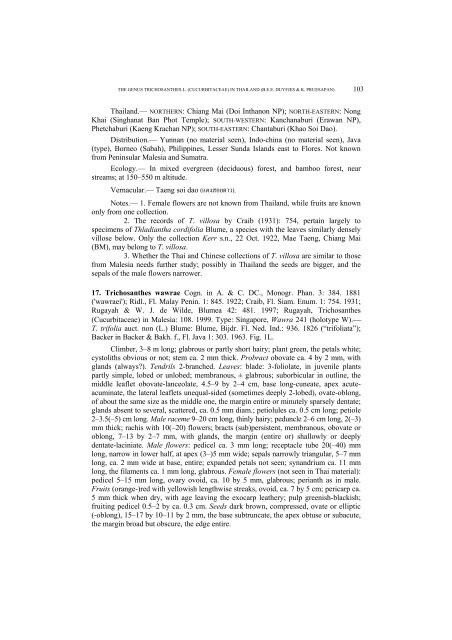The genus Trichosanthes L. (Cucurbitaceae) in Thailand ...
The genus Trichosanthes L. (Cucurbitaceae) in Thailand ...
The genus Trichosanthes L. (Cucurbitaceae) in Thailand ...
Create successful ePaper yourself
Turn your PDF publications into a flip-book with our unique Google optimized e-Paper software.
THE GENUS TRICHOSANTHES L. (CUCURBITACEAE) IN THAILAND (B.E.E. DUYFJES & K. PRUESAPAN) 103<br />
<strong>Thailand</strong>.— NORTHERN: Chiang Mai (Doi Inthanon NP); NORTH-EASTERN: Nong<br />
Khai (S<strong>in</strong>ghanat Ban Phot Temple); SOUTH-WESTERN: Kanchanaburi (Erawan NP),<br />
Phetchaburi (Kaeng Krachan NP); SOUTH-EASTERN: Chantaburi (Khao Soi Dao).<br />
Distribution.— Yunnan (no material seen), Indo-ch<strong>in</strong>a (no material seen), Java<br />
(type), Borneo (Sabah), Philipp<strong>in</strong>es, Lesser Sunda Islands east to Flores. Not known<br />
from Pen<strong>in</strong>sular Malesia and Sumatra.<br />
Ecology.— In mixed evergreen (deciduous) forest, and bamboo forest, near<br />
streams; at 150–550 m altitude.<br />
Vernacular.— Taeng soi dao (แตงสอยดาว).<br />
Notes.— 1. Female flowers are not known from <strong>Thailand</strong>, while fruits are known<br />
only from one collection.<br />
2. <strong>The</strong> records of T. villosa by Craib (1931): 754, perta<strong>in</strong> largely to<br />
specimens of Thladiantha cordifolia Blume, a species with the leaves similarly densely<br />
villose below. Only the collection Kerr s.n., 22 Oct. 1922, Mae Taeng, Chiang Mai<br />
(BM), may belong to T. villosa.<br />
3. Whether the Thai and Ch<strong>in</strong>ese collections of T. villosa are similar to those<br />
from Malesia needs further study; possibly <strong>in</strong> <strong>Thailand</strong> the seeds are bigger, and the<br />
sepals of the male flowers narrower.<br />
17. <strong>Trichosanthes</strong> wawrae Cogn. <strong>in</strong> A. & C. DC., Monogr. Phan. 3: 384. 1881<br />
('wawraei'); Ridl., Fl. Malay Pen<strong>in</strong>. 1: 845. 1922; Craib, Fl. Siam. Enum. 1: 754. 1931;<br />
Rugayah & W. J. de Wilde, Blumea 42: 481. 1997; Rugayah, <strong>Trichosanthes</strong><br />
(<strong>Cucurbitaceae</strong>) <strong>in</strong> Malesia: 108. 1999. Type: S<strong>in</strong>gapore, Wawra 241 (holotype W).⎯<br />
T. trifolia auct. non (L.) Blume: Blume, Bijdr. Fl. Ned. Ind.: 936. 1826 (“trifoliata”);<br />
Backer <strong>in</strong> Backer & Bakh. f., Fl. Java 1: 303. 1963. Fig. 1L.<br />
Climber, 3–8 m long; glabrous or partly short hairy; plant green, the petals white;<br />
cystoliths obvious or not; stem ca. 2 mm thick. Probract obovate ca. 4 by 2 mm, with<br />
glands (always?). Tendrils 2-branched. Leaves: blade: 3-foliolate, <strong>in</strong> juvenile plants<br />
partly simple, lobed or unlobed; membranous, ± glabrous; suborbicular <strong>in</strong> outl<strong>in</strong>e, the<br />
middle leaflet obovate-lanceolate, 4.5–9 by 2–4 cm, base long-cuneate, apex acuteacum<strong>in</strong>ate,<br />
the lateral leaflets unequal-sided (sometimes deeply 2-lobed), ovate-oblong,<br />
of about the same size as the middle one, the marg<strong>in</strong> entire or m<strong>in</strong>utely sparsely dentate;<br />
glands absent to several, scattered, ca. 0.5 mm diam.; petiolules ca. 0.5 cm long; petiole<br />
2–3.5(–5) cm long. Male raceme 9–20 cm long, th<strong>in</strong>ly hairy; peduncle 2–6 cm long, 2(–3)<br />
mm thick; rachis with 10(–20) flowers; bracts (sub)persistent, membranous, obovate or<br />
oblong, 7–13 by 2–7 mm, with glands, the marg<strong>in</strong> (entire or) shallowly or deeply<br />
dentate-lac<strong>in</strong>iate. Male flowers: pedicel ca. 3 mm long; receptacle tube 20(–40) mm<br />
long, narrow <strong>in</strong> lower half, at apex (3–)5 mm wide; sepals narrowly triangular, 5–7 mm<br />
long, ca. 2 mm wide at base, entire; expanded petals not seen; synandrium ca. 11 mm<br />
long, the filaments ca. 1 mm long, glabrous. Female flowers (not seen <strong>in</strong> Thai material):<br />
pedicel 5–15 mm long, ovary ovoid, ca. 10 by 5 mm, glabrous; perianth as <strong>in</strong> male.<br />
Fruits (orange-)red with yellowish lengthwise streaks, ovoid, ca. 7 by 5 cm; pericarp ca.<br />
5 mm thick when dry, with age leav<strong>in</strong>g the exocarp leathery; pulp greenish-blackish;<br />
fruit<strong>in</strong>g pedicel 0.5–2 by ca. 0.3 cm. Seeds dark brown, compressed, ovate or elliptic<br />
(-oblong), 15–17 by 10–11 by 2 mm, the base subtruncate, the apex obtuse or subacute,<br />
the marg<strong>in</strong> broad but obscure, the edge entire.
















